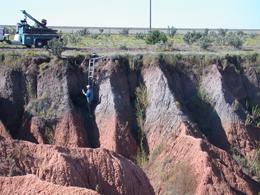
An independent study has cast more doubt on a controversial theory that a comet exploded over icy North America nearly 13,000 years ago, wiping out the Clovis people and many of the continent's large animals.
Archaeologists have examined sediments at seven Clovis-age sites across the United States, and did not find enough magnetic cosmic debris to confirm that an extraterrestrial impact happened at that time, says the report in the Proceedings of the National Academy of Sciences (PNAS). It is the latest of several studies unable to support aspects of the impact hypothesis.
In 2007, a team led by Californian researchers announced a theory that a comet or asteroid had exploded over the North American ice sheet, creating widespread fire and an atmospheric soot burst followed by a cooling period known as the Younger Dryas.
Sometime after this, the Clovis people, sophisticated large-animal hunters known for their spear points, mysteriously disappeared; the team linked their vanishing to the environmental effects of the proposed impact.
Key evidence came in the form of magnetic microspherules discovered in sediments at 25 locations, including eight Clovis-age sites. Richard Firestone, of Lawrence Berkeley National Laboratory in California, and his colleagues argued that the microspherules were remnants of cosmic debris from an explosion.
But in more than 18 months of sedimentary analysis, a team led by Todd Surovell, an archaeologist at the University of Wyoming in Laramie, was unable to detect microspherule peaks. Two of the seven sites the group studied were places where Firestone's team identified spherule peaks.
"I spent hundreds of hours at the microscope examining sediment samples," says Surovell, "and I didn't find any physical evidence to support their theory."
Standing firm
The other team isn't backing down. "Their study doesn't negate our hypothesis," says James Kennett, a palaeoceanographer at the University of California at Santa Barbara and one of Firestone's co-authors. Another co-author, avocational geophysicist Allen West of Prescott, Arizona, says that Surovell's group didn't use the correct technique to extract, identify and quantify the microspherules.
Several other groups have been unable to support important aspects of the comet theory.
In a PNAS article published in February, Jennifer Marlon, a doctoral geography student at the University of Oregon in Eugene, and her colleagues found no systematic burning of biomass - as would have occurred if continent-wide fires had happened - at the time of the Younger Dryas in pollen and charcoal records at 35 sites. And at the Ecological Society of America meeting in Albuquerque, New Mexico, in August, Jacquelyn Gill, a palaeoecology doctoral student at the University of Wisconsin-Madison, reported finding no evidence of massive burning in sediment cores taken from lake beds in Ohio and Indiana.
Kennett, however, calls these studies "flawed". In August, his team published a report saying they had found nanometre-sized diamonds, purportedly created during an impact, and soot in sediments dated to the Younger Dryas on Santa Rosa Island, off the coast of California.
More studies of the theory - both critical and supportive - are in the publishing pipelines at other journals.
Surovell's co-author Vance Holliday, an archaeologist at the University of Arizona in Tucson, and his colleagues have an article in press at Current Anthropology that says the archaeological and geochronological records don't support a collapse of Clovis people at the time of the purported impact.



Comment: For a more in-depth view, read: The Younger Dryas Impact Event and the Cycles of Cosmic Catastrophes - Climate Scientists Awakening